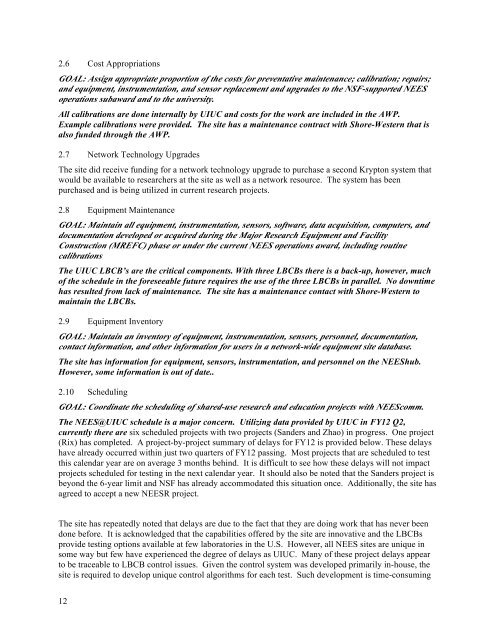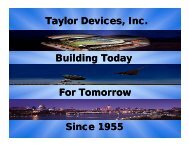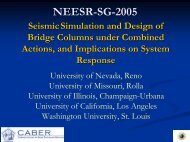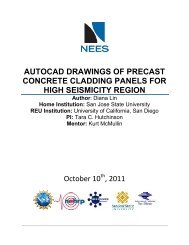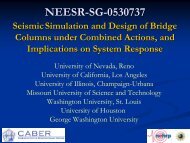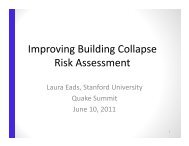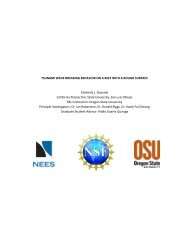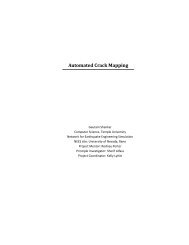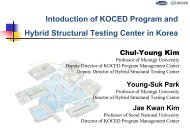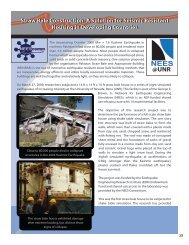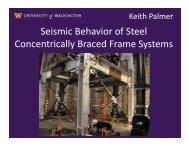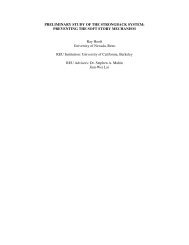Link to site visit report - Network for Earthquake Engineering ...
Link to site visit report - Network for Earthquake Engineering ...
Link to site visit report - Network for Earthquake Engineering ...
Create successful ePaper yourself
Turn your PDF publications into a flip-book with our unique Google optimized e-Paper software.
2.6 Cost AppropriationsGOAL: Assign appropriate proportion of the costs <strong>for</strong> preventative maintenance; calibration; repairs;and equipment, instrumentation, and sensor replacement and upgrades <strong>to</strong> the NSF-supported NEESoperations subaward and <strong>to</strong> the university.All calibrations are done internally by UIUC and costs <strong>for</strong> the work are included in the AWP.Example calibrations were provided. The <strong>site</strong> has a maintenance contract with Shore-Western that isalso funded through the AWP.2.7 <strong>Network</strong> Technology UpgradesThe <strong>site</strong> did receive funding <strong>for</strong> a network technology upgrade <strong>to</strong> purchase a second Kryp<strong>to</strong>n system thatwould be available <strong>to</strong> researchers at the <strong>site</strong> as well as a network resource. The system has beenpurchased and is being utilized in current research projects.2.8 Equipment MaintenanceGOAL: Maintain all equipment, instrumentation, sensors, software, data acquisition, computers, anddocumentation developed or acquired during the Major Research Equipment and FacilityConstruction (MREFC) phase or under the current NEES operations award, including routinecalibrationsThe UIUC LBCB’s are the critical components. With three LBCBs there is a back-up, however, muchof the schedule in the <strong>for</strong>eseeable future requires the use of the three LBCBs in parallel. No downtimehas resulted from lack of maintenance. The <strong>site</strong> has a maintenance contact with Shore-Western <strong>to</strong>maintain the LBCBs.2.9 Equipment Inven<strong>to</strong>ryGOAL: Maintain an inven<strong>to</strong>ry of equipment, instrumentation, sensors, personnel, documentation,contact in<strong>for</strong>mation, and other in<strong>for</strong>mation <strong>for</strong> users in a network-wide equipment <strong>site</strong> database.The <strong>site</strong> has in<strong>for</strong>mation <strong>for</strong> equipment, sensors, instrumentation, and personnel on the NEEShub.However, some in<strong>for</strong>mation is out of date..2.10 SchedulingGOAL: Coordinate the scheduling of shared-use research and education projects with NEEScomm.The NEES@UIUC schedule is a major concern. Utilizing data provided by UIUC in FY12 Q2,currently there are six scheduled projects with two projects (Sanders and Zhao) in progress. One project(Rix) has completed. A project-by-project summary of delays <strong>for</strong> FY12 is provided below. These delayshave already occurred within just two quarters of FY12 passing. Most projects that are scheduled <strong>to</strong> testthis calendar year are on average 3 months behind. It is difficult <strong>to</strong> see how these delays will not impactprojects scheduled <strong>for</strong> testing in the next calendar year. It should also be noted that the Sanders project isbeyond the 6-year limit and NSF has already accommodated this situation once. Additionally, the <strong>site</strong> hasagreed <strong>to</strong> accept a new NEESR project.The <strong>site</strong> has repeatedly noted that delays are due <strong>to</strong> the fact that they are doing work that has never beendone be<strong>for</strong>e. It is acknowledged that the capabilities offered by the <strong>site</strong> are innovative and the LBCBsprovide testing options available at few labora<strong>to</strong>ries in the U.S. However, all NEES <strong>site</strong>s are unique insome way but few have experienced the degree of delays as UIUC. Many of these project delays appear<strong>to</strong> be traceable <strong>to</strong> LBCB control issues. Given the control system was developed primarily in-house, the<strong>site</strong> is required <strong>to</strong> develop unique control algorithms <strong>for</strong> each test. Such development is time-consuming12


